In my last articles, Considerations for the DMR part 1 and part 2, I came to the conclusion that a DMR would be best suited with an optic system which focused more on speed than precision. Targets will always present at unknown ranges and only for a few precious seconds, so it’s in the best interest of a modern rifleman to use a faster, but less precise BDC based systems. Alone, a bdc is a great tool, but to really complete the concepts which I have worked on, we need to pair a BDC with a rifle that offers a flat trajectory and a bullet that offers reduced wind drift… insomuch as we can. In 5.56 this means a careful selection of a load designed to 1) match the BDC with the flattest shooting setup we can and 2) deliver superior performance in accuracy and diminished wind drift.
All Outa Time to Dial:
Understand that for a BDC reticle to be useful, it must get us within range to allow the trajectory arc to intersect with the target. The human body is only so tall, and only so wide… A little bit of wind drift at 300 might push you off a few inches, but the human body is wide enough to soak up a bit of wind error and land a hit. Likewise, if you estimate distance, hopefully it will be within the margin of error for a hit. Maybe it will hit low (target was further away then you estimated) or it might hit high (target was closer than your estimate). A poor hit within the margin of error (arrow to the knee?) is better than no hit at all. To ensure a *higher* hit probability, we need the flattest shooting projectile available so that error in range estimation can still land a hit.
Let’s do a mental exercise. Imagine a Red Rifleman using a AK47 with a hot new BDC system. You can calibrate a BDC for 7.62×38 just as easily, but note that the stadia are going to be far more separated compared to a 5.56 BDC. That’s because 7.62×39 is pokey and slow, and thus the 100 yard step stadia markings are further spread apart. As we estimate range, it becomes more critical that we get it right with the 7.62 as our margin for error diminishes. A few yards off the real range, and the round will hit the dirt or fly over the head. The trajectory of 7.62×39 is too punishing of mistakes. Your arrow to the knee with 5.56 might be an arrow in the dirt with 7.62×39 for the exact same range estimation error.
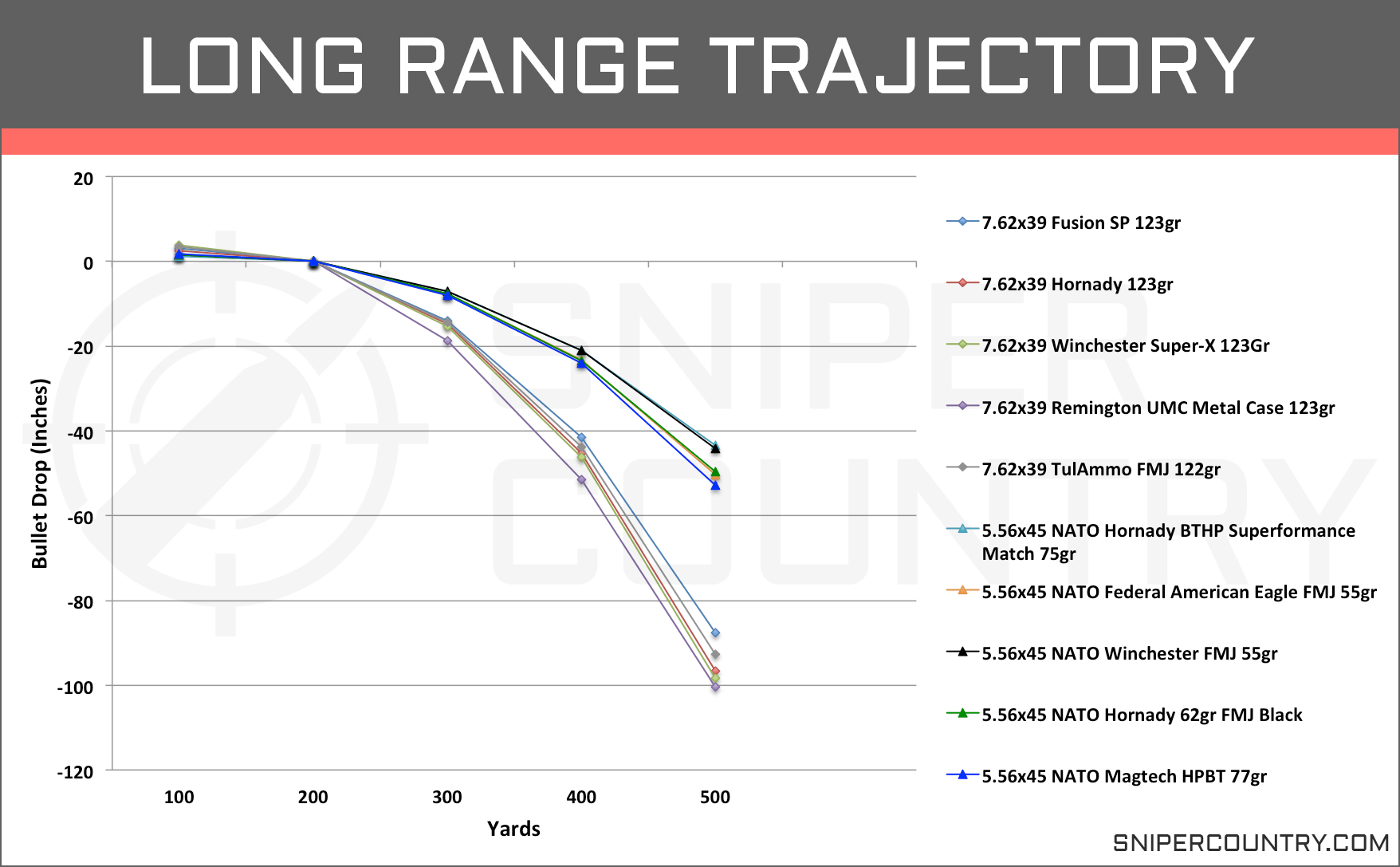
With more bullet drop, there must be more precise range estimation. The 7.62×39 is a poor choice for a DMR, obviously. Graphic from 5.56×45 vs 7.62×39 Cartridge Comparison I Sniper Country
So to be *more* useful, a BDC should be matched with a rifle system that squeezes out as much velocity as possible. Your range estimate will never be perfect. So use a projectile which flies as flat as possible to mitigate the error you are going to enter into the system. In my case, I want my 5.56 as speedy as possible. A rifleman recognizes that velocity (and RETAINED velocity) does indeed matter. A 20 it must be so it shall and thus it is! Aaahhhmen.
The Trijicon ACOG:
There are many models to choose from. Plenty of good arguments for and against this and that model. After owning and selling two (now on my third) I have two models in mind that are particularly suited well to a DMR style build.
My first choice for my 20 inch DMR is the TA01 ACOG. This model is a “legacy” model that hasn’t had much in the way of development. It is a simple reticle with 3 cross bars and fine BDC stadia. It does not feature fiber optic illumination. It is bare bones. Tritium and laser etched reticle only. With all the nifty features that other models contain, why choose the oldest product on the line?
The TA01 does some things well. It is calibrated to 55 grain ammunition from a 20 inch barrel. This satisfies the speedy projectile / BDC aspect. The drop stadia are tight and closely spaced. This is because the 55 grain bullet has a very flat trajectory inside of 600 yards. The other item that I prefer with this ACOG over something like a TA31F is that the reticle is always eye-catching. If you ever shot a Ta31 series under cover, you will note that the reticle washes out. When it washes out, you have a tiny black chevron. That’s not fast. It’s hard to find. It was one of the biggest disappointments I had when I got my first ACOG.
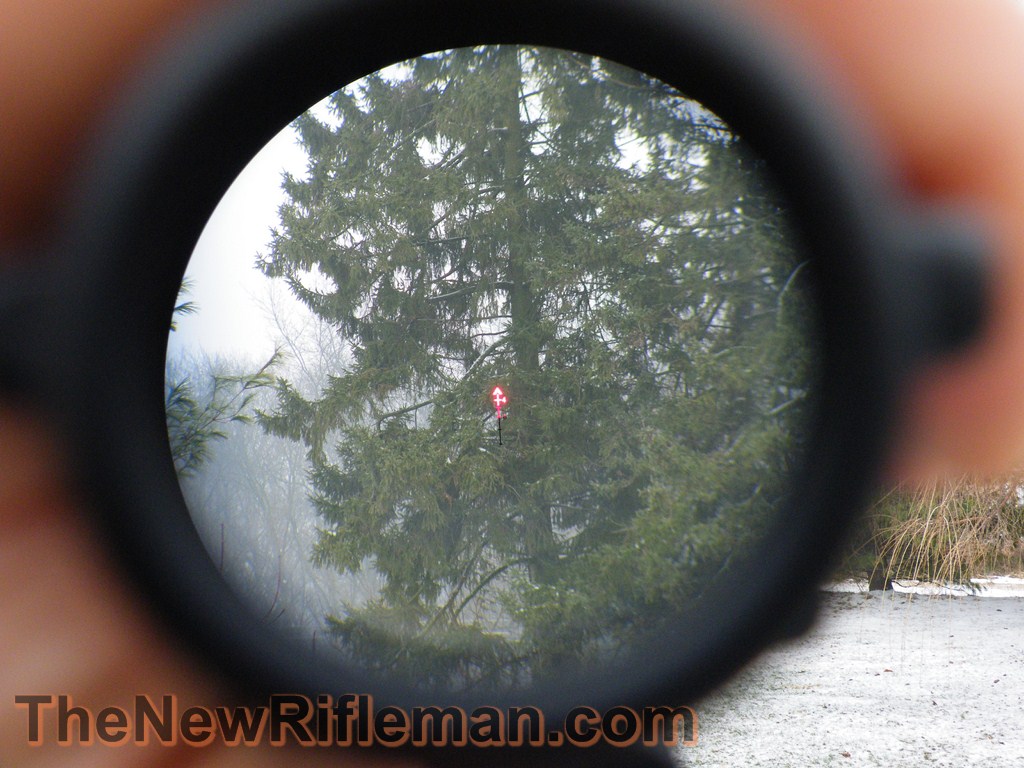
When your reticle is lit the chevron is awesome. When that tiny chevron washes out you have to FIND IT. SUCKS. Don’t turn on your flashlight! That reticle becomes difficult to find in shadowy conditions. SOLD IT.
The TA01 series avoids this by use of its large crossbars. Shooting from indoors to out still gives you a great the ability to bracket the target and FIRE. In addition, the TA01 is more affordable than its brother and sister models. Also full red-line illumination at night means the BDC works after dark. How far. To 800 yards. That’s kinda crazy, but I will take it!

While not as EYE popping, the TA01 series has no problem being easy to use and fast on target. The crossbars wont ever wash out when shooting from cover so you can bracket the target quickly.
Enter the ACSS:
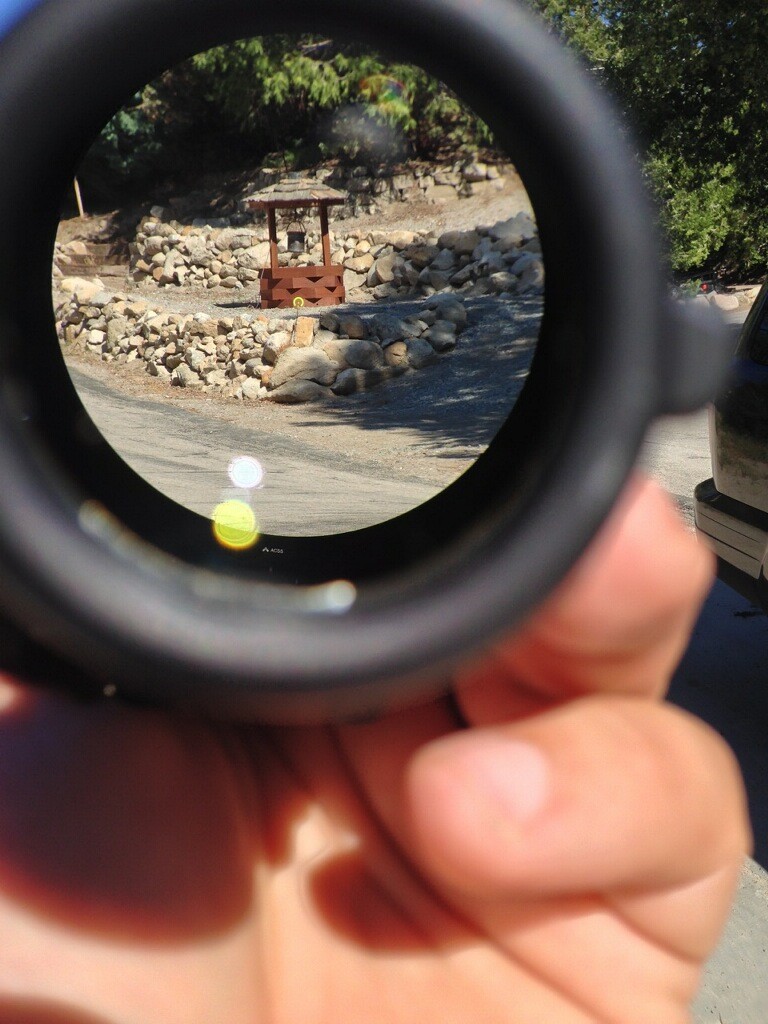
The illuminated center of the ACSS is a larger circle dot setup, and is superior to the chevron in size. The wind holds and ranging tools add tremendous value to the ACSS, but the reticle can still wash out when shooting from a dark area. CROSSBARS, HAVE YOU HEARD OF THEM? … THE GERMANS HAD THIS FORBIDDEN TECHNOLOGY IN WWII FOR GOD SAKE. They Work.
This is a good choice as well. It features a larger circle dot reticle and adds wind holds with various other methods of range estimation. It is calibrated for the 62 grain XM855 out of a 20 inch rifle. Nothing at all wrong with this model except the reticle would, in my opinion, still wash out a bit from shooting under cover or when used with a light. It’s a trade-off. I think either system (ACSS and TA01) are suitable optics for a DMR.
Fighting Wind:
I chose a flat shooting projectile pairing for my rifle and now I need a method for working in wind holds. The mind’s eye is a very powerful tool, and by utilizing some repeating patterns, we can extrapolate wind drops via mind’s eye visualization. With a BDC calculator, we can first develop a basic plan for our wind holds. Strelok gives us a visual of the reticle and target, and with a bit of imagination we can see patterns where we can apply repeatable holds.
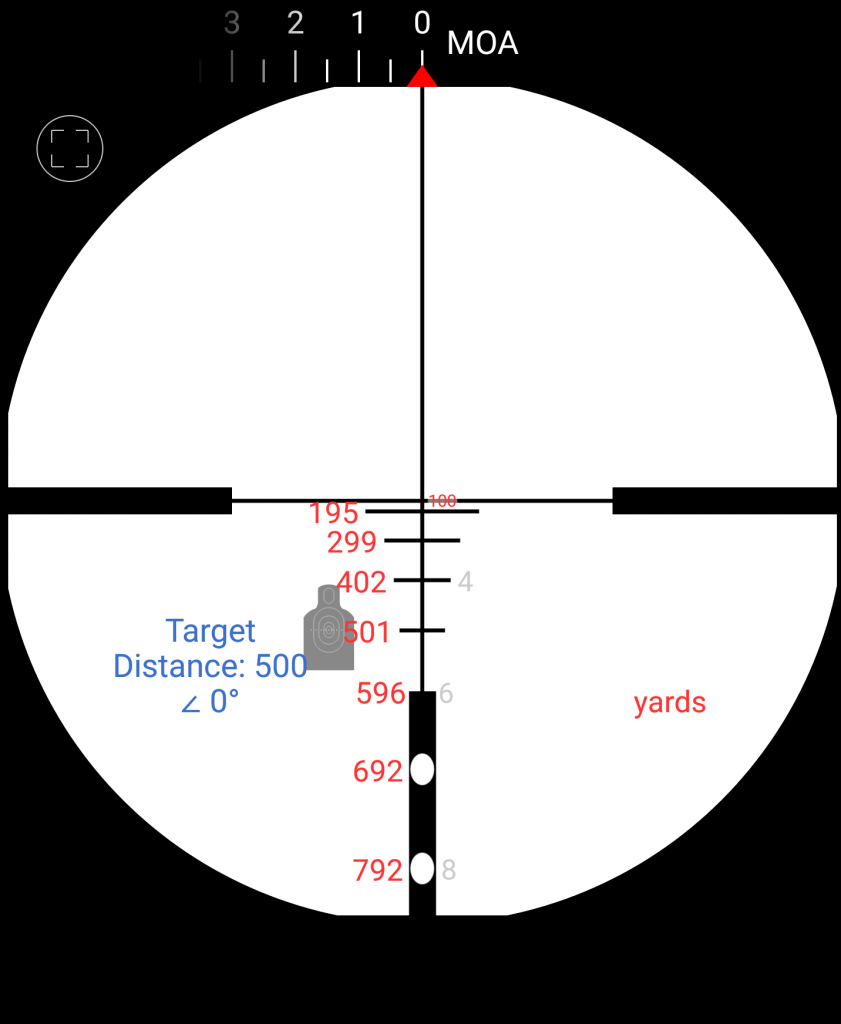
The technique is to imagine silhouettes shoulder to shoulder. At 500 yards with full value 10mph wind, your hold would be a third man standing shoulder to shoulder to your intended target. At 400 the hold would be an invisible man standing right next to your target. At 300, hold just off the arm of the target. At 200 and 100 yards, hold just right of center of mass.
Those holds are visually do-able and give you a better chance at a hit with the 55 grain M193 than pure guestimation. Even a basic system is better than no system. Not the ideal round to shoot in the wind, but simply holding off using mental visualization can help you in buck the wind. I would be hesitant to use the same technique at 600-700 as there is only so much visualization you can do before your just aiming into the grass. I feel 500 yards is the limit of the technique with this projectile.
If you have an ACSS system, then you have added holds to aid your shooting in wind; the holds on the ACSS are calibrated to 5mph crosswind and a 62 grain bullet traveling out of a 20 inch rifle.
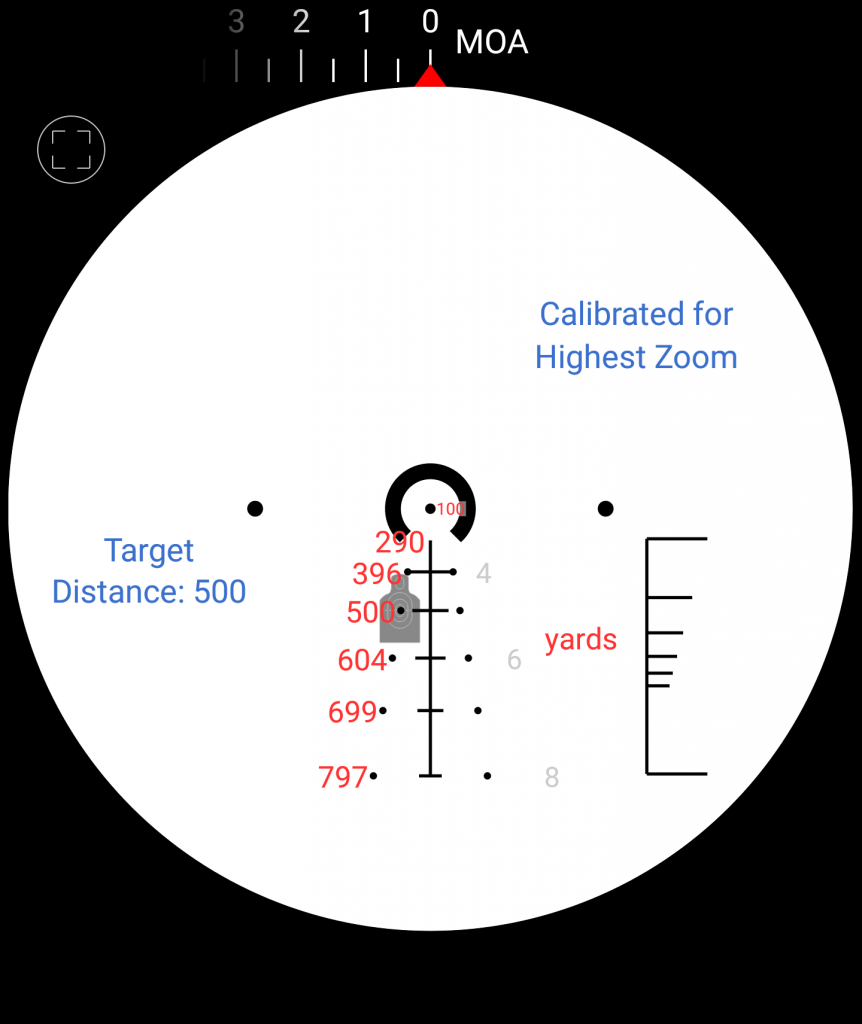
The ACSS is a more science based approach and is superior to using mental imagery, but you still have to use SOME mental imagery to shoot in 10mph crosswind. The extra ranging tools are useful if you have time to use them, and the ACSS is a solid package save for the washout issue. I would add a supplemental red dot so you mitigate the wash out issue with a separate optic.
What About Variables?
Another good choice, but I avoided them mainly because of the added weight on a DMR. At a portly 9lbs, the HBAR is getting hefty. I want the benefits of the heavy barrel, but the sacrifice is weight. Thus, I made the decision to use ACOG’s for the build over the more versatile variable optic. In most other circumstances, I would take a variable as they have so many additional capabilities that it would take a separate article to cover them all.
There is No Spoon:
Many shooters hate that a fixed BDC ties you to a single cartridge. In theory, yes this would be a problem, but in reality you can find many other projectiles that fit the BDC. The heavy, aerodynamic .223 loadings work amazingly well with the TA01’s BDC. The 55 grain speedster contrasts really well with the slower but more aerodynamic 70+ grain bullets.
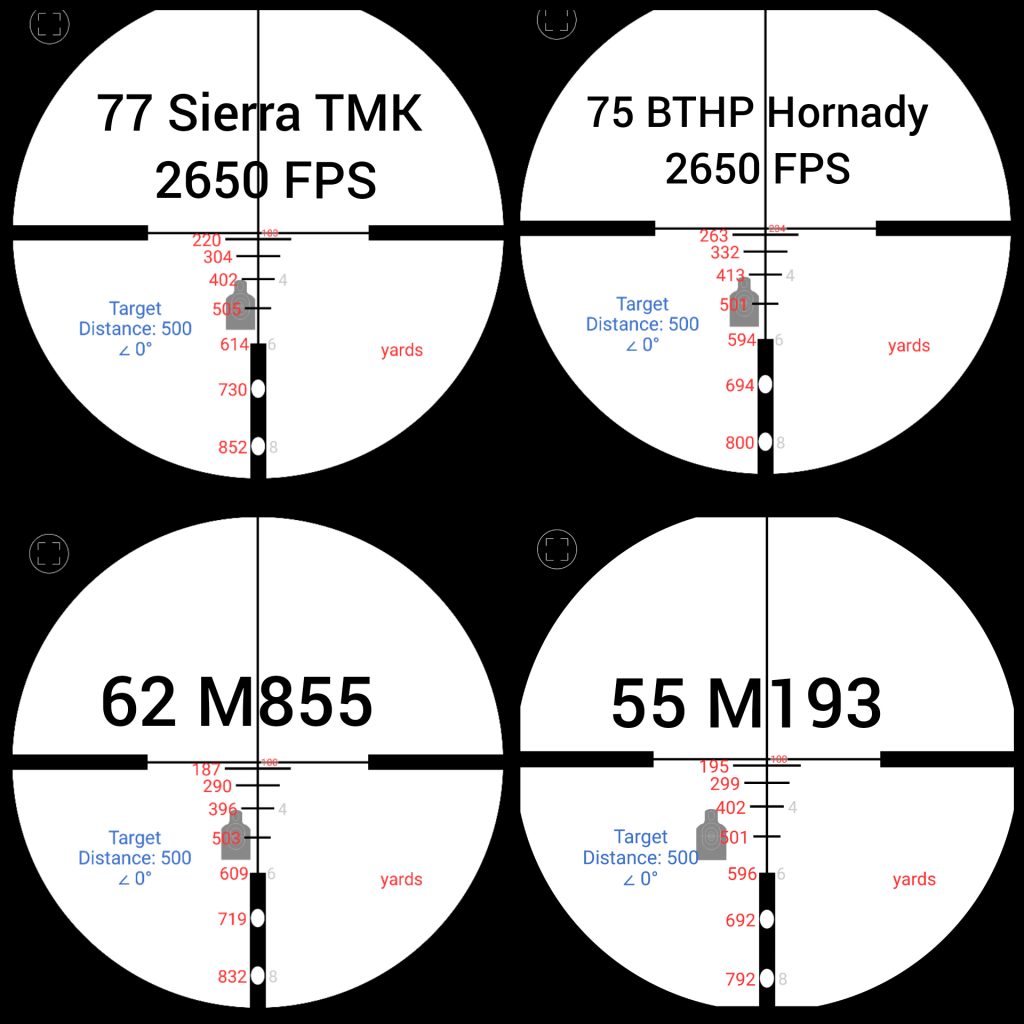
So the M193 TA01 reticle is still quite useful for the heavier match bullets. The trajectory curve lines up past 300 yards very well and continues to be useful out to 700-800 yards depending on the load. Also of note is how tight the wind holds become. Look at the 77 TMK Sierra at 500 yards… with a 10mph wind your hold is just right of the arm! Coupling these reticles with a 70+ grain loading will offer solid shooting results and I intend to make use of them.
Wrapping Up:
The ACOG still represents a quality optic for a rifleman, though it has been eclipsed by the feature packed variable optics as of late. In my opinion, a DMR benefits from the velocity and accuracy of a long heavy barrel. Since this is the route I chose, I also wanted to mitigate the weight with a lighter optic over a variable with mount. The ACOG TA01 and ACSS offer a great pairing to a 20 inch gun and both feature useful elements for the rifleman. While the TA01 is dated from a design standpoint, there is still benefit to its low light BDC and useful reticle which does not wash out. The ACSS represents a more feature packed optic which gives the rifleman much better visual data regarding wind holds, and would make another excellent choice save for the fact that washout is still a problem. Other ACOGS, such as the TA31 series, lack both wind data and also lack a solid, highly visible reticle in adverse lighting conditions… thus I would spring for TA01 or an ACSS system.
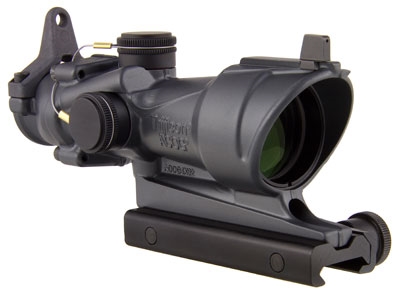
The TA01 models now have provisions for the ACOG integrated BUIS. In addition, they can be outfitted with a RMR just like every other model of ACOG. These model changes haven’t made their way into the descriptions and photos of the TA01 in the retail environment.
So for part 4 we will explore the statistics of my build. Let’s pit a modern 10 inch carbine against the 20 inch dinosaur and compare / contrast hit statistics using some analytical software. Much like accuracy, I believe hit percentage improves with incremental changes: longer barrel, better bullet, more accuracy… all will add incremental improvements to a rifleman’s hit rate. Without a squad of shooters to test in a controlled environment, I will use the next best thing to extrapolate some data: The AB Analytics Package.
Lothaen OUT!





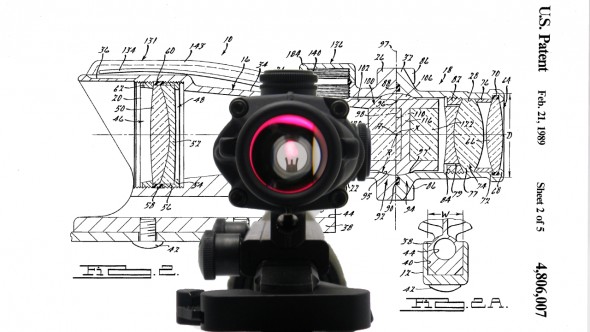


Yes. I’ve decided to stay with my old-school TA01. I only wish it had a battery powered reticle for low light. The tritium is getting old.
The last photo shows a TA01-NSN, which is designed for a 14.5″ barrel firing M855 and has a reticle that only goes to 600 yards. It’s fundamentally different than the original TA01.
The photo may be a stock photo, but when I cover the TA01 shortly you will see that they recently gave it all the provisions for a BUIS setup just like the TA01NSN. You just have to add them yourself. It does not have the smooth look of the old TA01 models we have been used to seeing.
that’s excellent news, and I see that version pictured now on Trijicon’s website.
Great read! I still think the TA01 is a very viable option, but the TA02 is definitely a worthy look as well. I’m a big fan of the LED illumination models. One thing I’ve done differently is use .308 BDCs, though. I’ve found that 77gr loads actually conform closer to the .308 BDC, though the differences aren’t that much and both work just fine at the style of shooting the ACOG was designed for.
I did forget to mention the TA02 which also matches the criteria I laid out for my build. Thanks for mentioning it!
Hi Lothaen,
I been considering an ACOG or Primary Arms PAC3X with ACSS, drawn in by the mechanical simplicity and lighter weight versus a variable. But your “most other circumstances, I would take a variable as they have so many additional capabilities” has me thinking about a 1-6X again.
I’m intrigued by the Primary Arms Raptor for the ACSS mostly, but the Razor HD seems to be the scope that all others are being compared against.
Which variable(s) do you recommend these days?
Jeff
There are so many good variables out there right now! On a budget, the Atibal XP8 blew me away as it was the first chinese optic that made me really feel like it was a quality piece. This model is a OEM that exists also in the form of the Primary Arms 1-8 ACSS and the Vortex Strike Eagle 1-8 so any of those provided they are held to the same quality as the Atibal sample would be good to go.
The main problem with full reticle illumination in variables is light bleed and lack of daytime brightness…the above would all suffer from that.
So past that I would go for centsr dot illuminated variables. These are red dot bright and really bring the optic out at 1x: leupold Firedot models, razor HDII, trijicon Accupoints, and the Steiner P4XI all have red dot bright illumination and no light bleed out the front of the optic.
So those are the variables I like, some of which I have owned and others I have studied and I am interested in.
Thank you! I’ll check those out. Are there any issues with astigmatism and center illuminated dots? My Aimpoint T1 reticle is like an oblong smear.
Is the Razor still on your One Gun from 2015? (referring to https://www.thenewrifleman.com/one-gun-high-power-3-gun-project-rifle-completed/ and other photos)
They bloom, but thats only due to cranking up the brightness. At normal brightness levels they were sharper than a red dot.